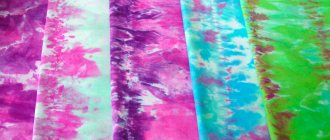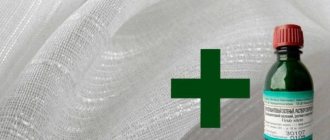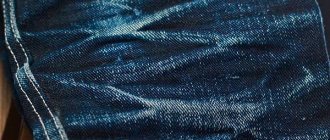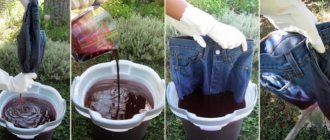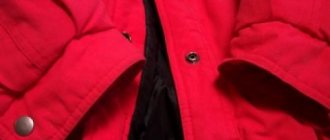Share on social media networks:
Almost every home has a blazer in their closet. These jackets come in different styles and colors. In addition, the cost is quite reasonable, so many can afford to buy such a thing. But sometimes it happens that the color of winter outerwear gets boring, and a person immediately looks for a solution to his problem. Owners of such products often wonder how to dye a bologna jacket at home? How to decorate bolognese pants? How to dye a black nylon parka? First you need to understand the tools and paints, and also not forget about the properties of the material and dyes.
Preparing for painting
Before you start work, you need to prepare everything you need, namely:
- things intended for dyeing;
- container and devices for turning fabric;
- dyes and rinses.
How to properly prepare clothes for dyeing
Before painting, you will have to remove the fittings from the clothing.
- First of all, you should wash your clothes thoroughly. If there are old stains on the fabric from grease, oil or other difficult-to-remove substances, you should definitely get rid of them. Otherwise, the fabric in this place will be dyed unevenly, and clearly visible stains will remain, which will greatly spoil the appearance of the product.
- Then you will have to remove the accessories - cut off buttons and decorations, flog metal zippers, since the surface of these parts can be damaged when painted and subsequently become covered with rust.
- If you decide to dye a new product made of cotton or linen, you need to remove the layer of starch that the manufacturer usually impregnates such fabrics with. To do this, prepare a soap solution, add a little soda and boil the clothes for 25 minutes, after which they rinse thoroughly.
- When dyeing wool yarn, you need to make sure that the threads do not intertwine or get tangled. To do this, it is divided into small parts and collected into loose skeins, which are tied in two or three places with twine.
Selecting containers and equipment for coloring
Once the clothes are prepared for dyeing, you can begin choosing a container.
- Any clean utensil will do, be it an enamel basin or an aluminum pan. The main thing is that there are no traces of scale or soot on the inner surface of the metal.
- Particular attention should be paid to the size of the container. The pan should be of such a volume that the thing to be painted is located freely in the solution, does not squash and does not rise above the surface of the water.
To stir and turn the product while working, you will need wooden tongs. If you don’t have such a device on your farm, you can use ordinary wooden sticks, after first clearing the surface of knots and uneven surfaces.
It is better to take soft water for the procedure, for example, rain or melt water. If this is not possible, then ordinary tap water can be softened with baking soda, for which 1 tbsp. l. powder is dissolved in 10 liters of water.
Updating the shade of a leather jacket
Genuine leather is the material from which jackets, raincoats and other wardrobe items are made. Products made from it look respectable. Things can be worn for up to 10-20 years. During this time, abrasions form in the area of the collar, belt and cuffs, which significantly worsens the appearance.
You can get rid of them by repainting your leather jacket. In a different color, the thing takes on a second life. If only a certain part of the product has lost its appearance, the entire jacket will still have to be repainted.
Otherwise, the treated areas will look like patches. It is not recommended to radically change the color or repaint the jacket from a dark to a light tone. It is also recommended to choose aerosol paints, since they are easier to work with than paste.
Attention! Salamander and Tarrago paints in spray or paste form are suitable for leather products.
The staining procedure is as follows:
- the surface of the product is wiped with a damp foam sponge;
- the jacket is hung on the trempel so that the bottom does not touch the floor;
- shake the can of paint and spray it evenly over the entire surface;
- After the first layer has completely dried, the product is painted again.
It is better to carry out work outside. In natural light, the uniform distribution of paint is clearly visible; walls, floors and furniture will not get dirty. Using paste paint, you will have to process the jacket manually using a piece of foam rubber. In this case, you can apply too thick a layer and the item will lose its appearance.
How to paint a product yourself
The choice of paint depends on the composition of the fabric and the preferences of the owner of the clothing.
Textile paint is available in the following forms:
- aerosol,
- pastes,
- powder.
It is suitable for use when dyeing by hand or in a washing machine. The choice of dye depends on the composition of the fabric and the personal preferences of the owner of the clothing.
Before starting work, it is necessary to accurately determine the composition of the product. If the label is erased or lost and it is not possible to find out reliable information about the composition, you can set fire to the thread from the product. Synthetic and natural fibers release different “flavors” when burned:
- synthetics smell like chemicals;
- natural wool or cotton emits the smell of burnt hair.
The easiest way to repaint a thing is from natural materials. Synthetics are difficult to paint and quickly lose their newly acquired shade.
The general rules for using universal fabric paint are the same regardless of the manufacturer of the product. However, when starting coloring, it would be useful to study the instructions included with the product in order to know exactly the dosage and nuances of using a particular dye.
Important! All work with the dye must be carried out with rubber gloves.
If the dye does not require heating the water, then it is better to carry out the work in the bathroom, having previously protected easily soiled items with waterproof film. Then the following activities are carried out:
- Pour paint into a container with warm water and stir thoroughly. The amount of water and dye is determined in advance depending on the weight of the clothing and the dosage indicated by the manufacturer on the packaging.
- The product is dipped into the solution and left for half an hour, stirring occasionally and making sure that the fabric does not wrinkle.
- As soon as the product acquires an intense black color, it can be removed from the solution and rinsed in cool water, adding 1 tbsp. l. vinegar.
Important! If you need to paint several things, you need to paint them one by one.
Often the instructions require heating the coloring solution, then proceed as follows:
- The container with paint dissolved in water is placed on low heat and heated to a temperature of 60 °C.
Important! When dyeing wool and silk, add 50 ml of 25% vinegar essence to the solution.
- The item prepared for painting is immersed in a hot solution for an hour, maintaining a constant temperature of no more than 60 ° C and stirring occasionally.
- After the allotted time has passed, the product is washed in a machine or by hand at a water temperature of 40 ° C and rinsed with the addition of vinegar.
In the future, you should wash and rinse items painted black separately from the rest of your clothes, and add vinegar to each rinse.
Preparing bologna outerwear for wearing:
- After dyeing, wash the product well with washing powder. This can be done by hand or in a washing machine. Experts recommend washing by hand, since the washing machine drum can become stained and will be difficult to wash later.
- You can dry your jacket in a dryer or in the fresh air.
- After drying the jacket, return the removable accessories (hood, chains and buttons) to their places.
If you are not sure that you can dye a jacket yourself and without consequences, then practice first on old and unnecessary things. This way, you will reduce the risk of damage to your precious item.
If you want to experiment with old items or add some interest to them, dyeing your clothes is a great solution. For these purposes, you can find special dyes for various fabrics in hardware stores. In addition, at home there are always materials at hand that can be used to dye fabric, for example, fresh vegetables, berries and spices.
If you want to experiment with old things or make them look attractive, a great solution is to dye your clothes in
Below we suggest that you familiarize yourself in more detail with how to dye clothes at home, and what is important to take into account so that you don’t end up saying goodbye to your favorite item.
If the jacket is of high quality, it will last a long time. However, when it begins to get boring, the need arises to dye the down jacket, thereby giving it freshness and novelty. For this purpose, you can go to the dry cleaner, or paint your outerwear yourself.
- container for diluting paint;
- salt;
- dye for textile clothing.
Of course, it is better to entrust the matter to professionals who know all the intricacies of the procedure and can choose the right paint for a particular fabric, which is important. After all, dyeing a coat is very difficult, and the dyeing results may not live up to expectations. Be prepared for the fact that after drying the shade will not turn out as expected, or there will be streaks of paint left on the coat, which is almost impossible to determine during the painting process.
It is very important to choose the right dye for painting things. You should not opt for liquid inks or paints that are not intended for this type of fabric. Often, dyes can be purchased at hardware stores, art salons and shops. There you can also consult which product is more suitable for dyeing clothes made from a particular fabric.
Don’t forget to remove the accessories from your clothes first so that they don’t get damaged during the process of repainting the down jacket. You can paint things either by hand or in a machine. The dye should be diluted in 10 liters of water, adding 150 g of salt. After this, we lower the down jacket into the prepared composition for the time specified in the instructions for the paint used. In order for all clothes to be dyed evenly, it is important to eliminate creases and wrinkled areas.
Upon completion of the procedure, the down jacket should be hung on a hanger without twisting it. After drying, it will be possible to evaluate the color qualities, and the procedure may have to be repeated.
Down jackets are often wiped, and in some places the color disappears, becoming duller. Also, things often deteriorate after improper washing. Dyeing a product that has changed its color will help save it. It’s worth understanding how to dye a down jacket yourself.
Dyeing in the washing machine
For dyeing, the washing machine is set to a washing mode in which the cycle duration does not exceed 30 minutes.
You can use a washing machine to dye clothes. Modern dyes have compositions that are completely safe for the operation of household appliances, and the process itself is easier and faster than manually.
- Pour 0.5 liters of hot water into the container and pour out one package of dye. Mix thoroughly, trying to dissolve all grains of powder and obtain a homogeneous mixture.
- Things are turned inside out and loaded into the washing machine. When dyeing, do not use washing powder or conditioner.
- A dye is poured into the machine. You can simply tear the paint bags and put them on top of your clothes.
- When dyeing silk or other delicate fabrics, add 150 ml of 25% vinegar essence.
- Set the washing mode in which the water temperature does not rise above 60 ° C and the cycle duration is no more than 30 minutes, including rinsing.
- After dyeing is completed, wash again at a temperature of 40 ° C, which will allow the paint to adhere well.
The products are dried by laying them out on a horizontal surface away from radiators and avoiding direct sunlight.
To completely clean the machine drum of traces of dye, you need to carry out one cycle in the “rinse” mode using chlorine bleach.
Natural dyes
In addition to aniline and acrylic dyes, there are natural dyes, which are ordinary products. You can dye the product black using coffee, tobacco or hair dye:
- Coffee will help restore the intense black color of fabric that has lost its original appearance. To dye, you need to prepare enough instant or boiled coffee so that the liquid can cover the item being dyed. The stronger the drink, the brighter the color of the fabric. The coffee is brought to a boil, removed from the heat, and the item prepared for painting is immersed in a pan for an hour. The longer the fabric is in the solution, the more colored the fibers will be.
- Instead of coffee, you can take tobacco. To prepare a dyeing solution, pour 15 g of tobacco into 1 liter of water and boil it, after which the product intended for painting is immersed in the container.
Dyeing fabrics with natural dyes: step-by-step instructions
How to dye fabric if you only have the contents of the refrigerator and groceries?
The following step-by-step instructions will help you avoid mistakes:
- Grind the coloring ingredient with a knife or grater, if necessary.
- Place in a saucepan and add water in a ratio of 1 to 2.
- Bring to a boil and leave for an hour. For a more saturated pigment, you can leave the liquid overnight.
- Strain the water thoroughly: make sure that there are no small pieces left in it - otherwise they will leave stains on your clothes.
- Prepare a paint fixative: if you are using berry or fruit juice, add half a cup of salt to 2 liters of water, bring to a boil, put a cloth there and boil for an hour. The proportions can be increased according to the size of the item being painted. If you paint with vegetables, spices or herbs, you need a vinegar solution. To prepare it, add four equal portions of water to one part of vinegar, put a cloth there and heat over low heat for an hour.
- After the time has passed, remove the item from the fixative solution and rinse in ice water.
- Dip the fabric into the dye and leave it for a while - the longer it stays there, the richer its final color will be.
When the product dries, the fabric will turn pale. Take this into account and paint the product longer if necessary.
Useful tips
For those people who don't often dye items from their wardrobe, the helpful tips and tricks listed below can come in handy.
- If you have to paint a product for the first time, it is better to practice on an old unnecessary thing that you don’t mind throwing away if it fails.
- To accurately determine the required amount of dye, the textiles must be weighed.
- If the item to be repainted is intended to be remade, then it should be torn into pieces in advance.
- Uneven coloring of synthetic fabric can be corrected by immersing the product in a hot soapy solution.
- Items dyed black should be washed separately from other clothes. The fact is that they can fade and ruin all the other things in the drum.
Dyeing your favorite clothes black, done at home, will not only return the items to a bright, rich color, but will also save time and money. The main thing is to buy paint from trusted manufacturers, follow the instructions and listen to the advice of experienced housewives.
Preparatory stage
Dying a polyester jacket at home is easy. This material is synthetic, so it can easily change color. To make the process go quickly, prepare the dye, necessary tools and container in advance. Observe safety precautions during work.
Determination of fabric type and composition
First you need to determine the fabric of your outerwear. This information is located on the product label. If the polyester content is 100%, then dyeing will be easy. But if other tissues are present, it is not always possible to obtain the desired result. The jacket fabric must contain at least 60% polyester.
Attention! The product label is located in the collar area or on the left side in the side seam.
It is worth paying attention to secondary materials. There will be no problems with dyeing if the product contains linen, cotton, viscose or silk. If the item was treated with a stain-repellent coating at the factory, it may not allow the paint to be absorbed or it may not be absorbed evenly. As a result, the jacket will be damaged.
Definition of color
When you decide to dye a synthetic bolognese jacket at home, the second stage of preparation will be to determine the color of the product. What you get in the end depends on the initial tone. You can safely dye white, beige, cream, pink and blue items. If the item is colorful and has several shades, then it is better to buy a dark dye. So, there is a greater chance that the original shade will overlap.
Buying dye
There are dyes that are suitable for one type of fabric, and there are universal ones. If the color of a polyester item changes, you can use any chemical dye. It is important to study the composition first. The manufacturer always indicates this information on the back of the package.
If there is no information, it is better to find another dye option. Often the necessary information is provided on the company’s official website. The paint is used when it is necessary to paint a polyester or leather jacket at home. Dyes are produced in the form of a water-soluble powder or aerosol.
Organization of the work area
The process of dyeing outerwear is messy and labor-intensive. Therefore, before starting, you need to carefully prepare the workplace. If there is a carpet on the floor, it is better to remove it and lay newspapers, cardboard, and film on the laminate or linoleum. There should be wet and dry wipes, a towel, and detergent in the access area. It is better to work in overalls that cover the face and bare parts of the body. If you don’t have it, then you need to wear old things that you don’t mind throwing away.
Removing hardware
Before dyeing a jacket at home, you must remove all accessories from the product. This includes: buttons, rivets, chains, pins, chains and everything else that can be easily unfastened. Be sure to check your pockets.
Attention! You need to remove the accessories very carefully so as not to break the product or tear the jacket.
It is possible that they contain forgotten important records or money. If the item has serious damage, or some parts are firmly attached, it may be better to have the jacket altered or repaired in a studio.



